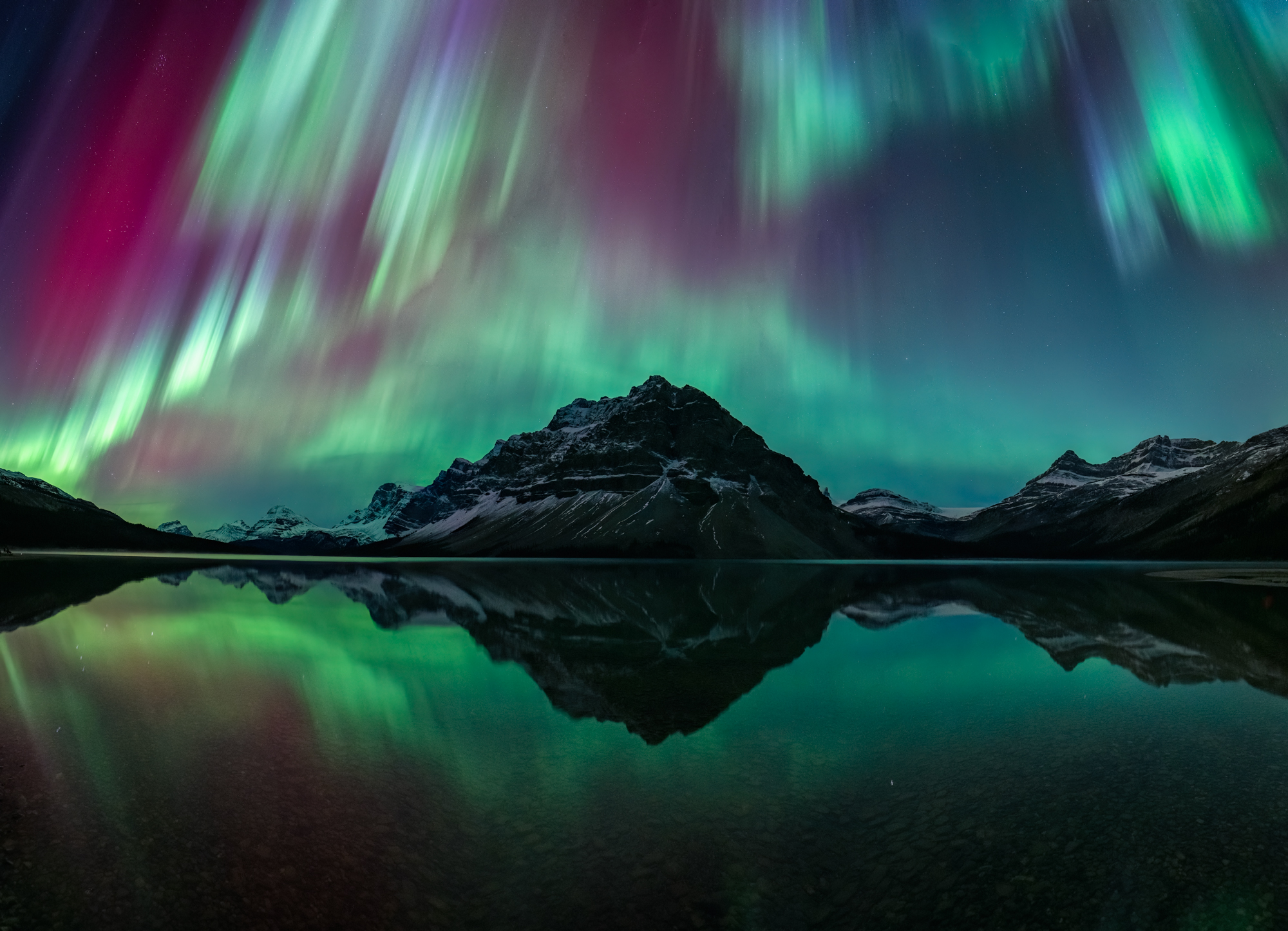
Winter Skies: Aurora & Orion Chase Photography Workshop!
Dates: November 9-15, 2025, and December 2-8, 2025
It is no secret that winter is my favourite season, and there are few places in the world that rival the Canadian Rockies for winter photography. The snow, ice, and frost formations transform the landscape into breathtaking and dreamy scenes that look as though they come straight from a storybook. Snow is the great simplifier of often complicated landscapes.
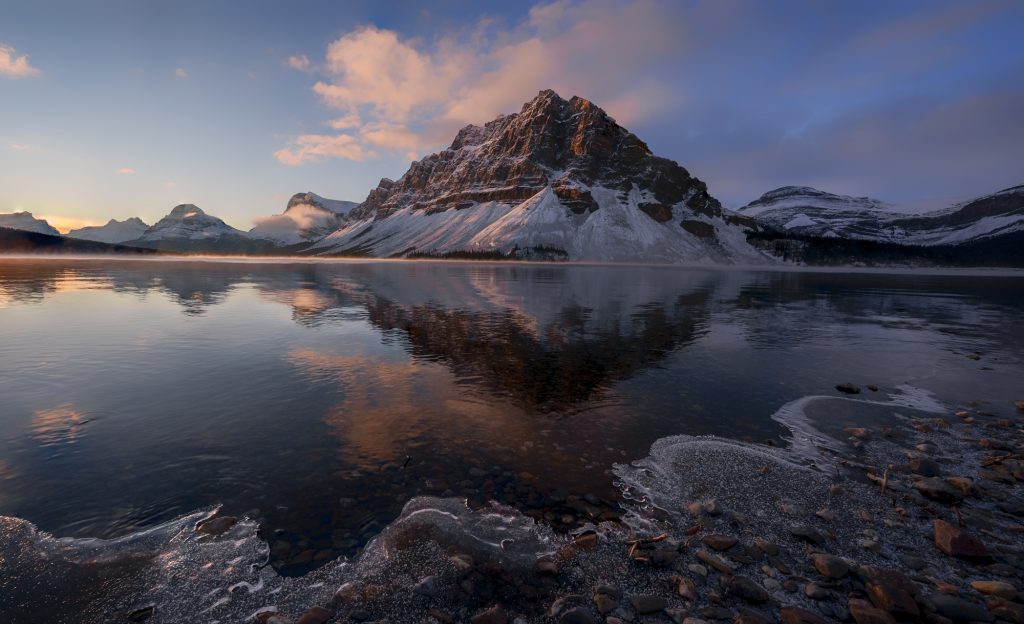
What you may not know, is that for a brief time in November, magic happens! This is a period of transition from autumn into the stillness of late winter when some lakes begin to freeze, while deeper, jewel-green rivers and glacial lakes are still flowing.
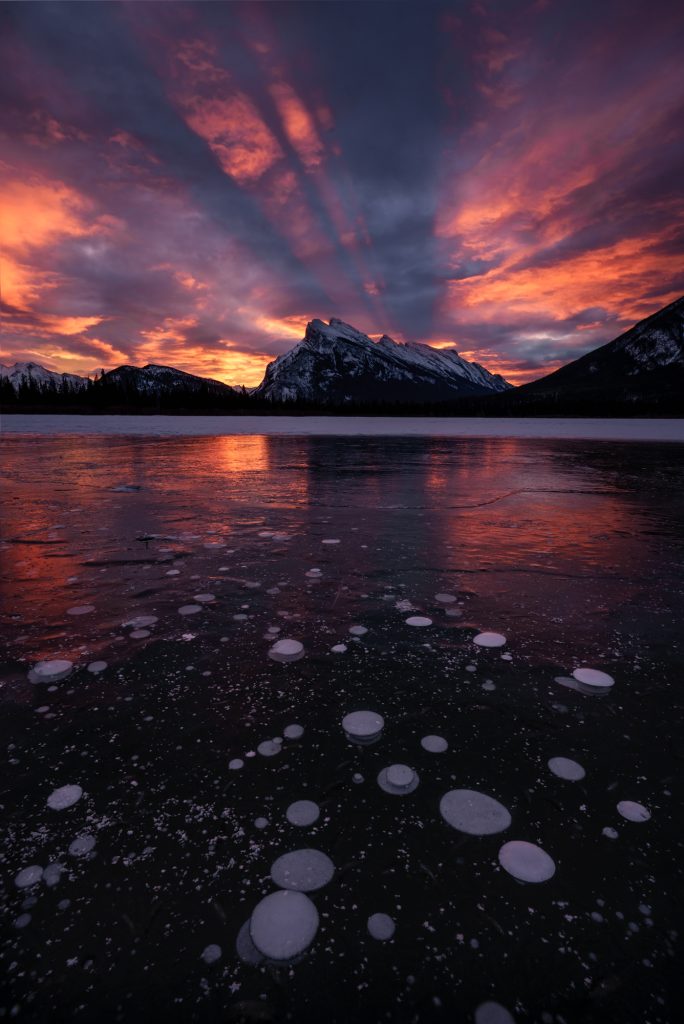
In the frozen lakes, early season methane bubbles begin to form. One of my favourite things about November is to get out and hunt for the frozen methane bubbles on the lakes before they get covered with snow for the winter. Yet in the deeper bodies of water, the contrast between the jewel-tones of the lakes and rivers against the snow is breathtaking.
November skies are even more special than the endless opportunities to seek the frozen methane bubbles, frost flowers (yes! if temperatures are cold we can see frost flowers!), and reflections. Locals refer to this time of year as “never miss a sunrise November.” Although there are never any guarantees with weather, we get more fiery sunrises in November than any other time of the year.
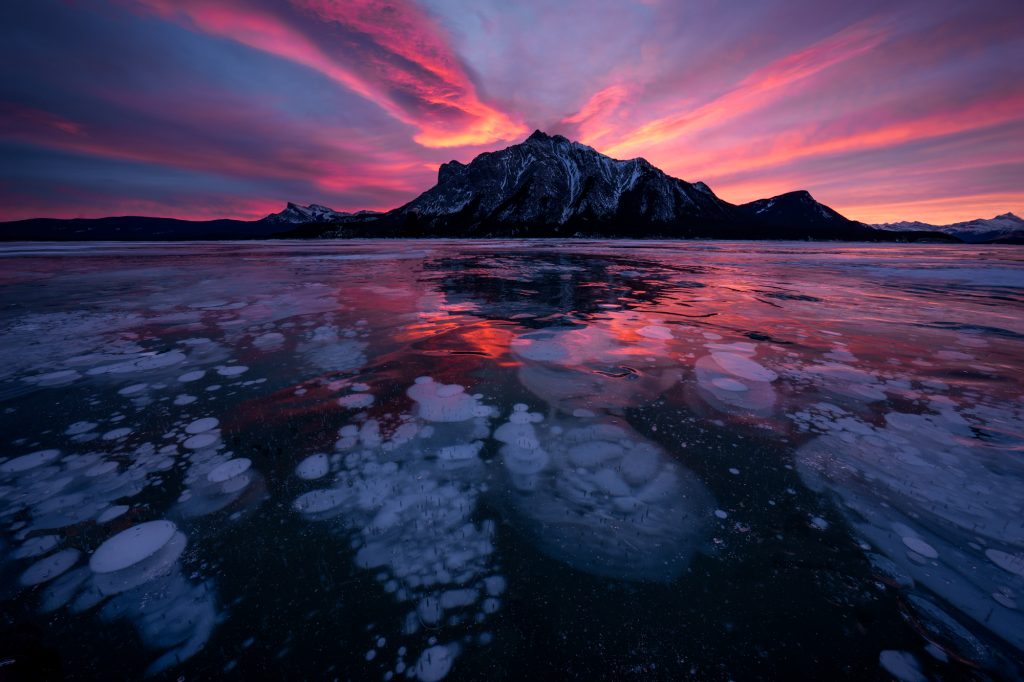
When the sun goes down, the winter night sky dances over the ice and snow. We have truly dark skies here in the Canadian Rockies. Have you have never experienced a Bortle 1 sky? The stars in the National Parks are so bright it will feel like you can reach out and pluck them from the sky, or scoop them out of the reflections in the water.
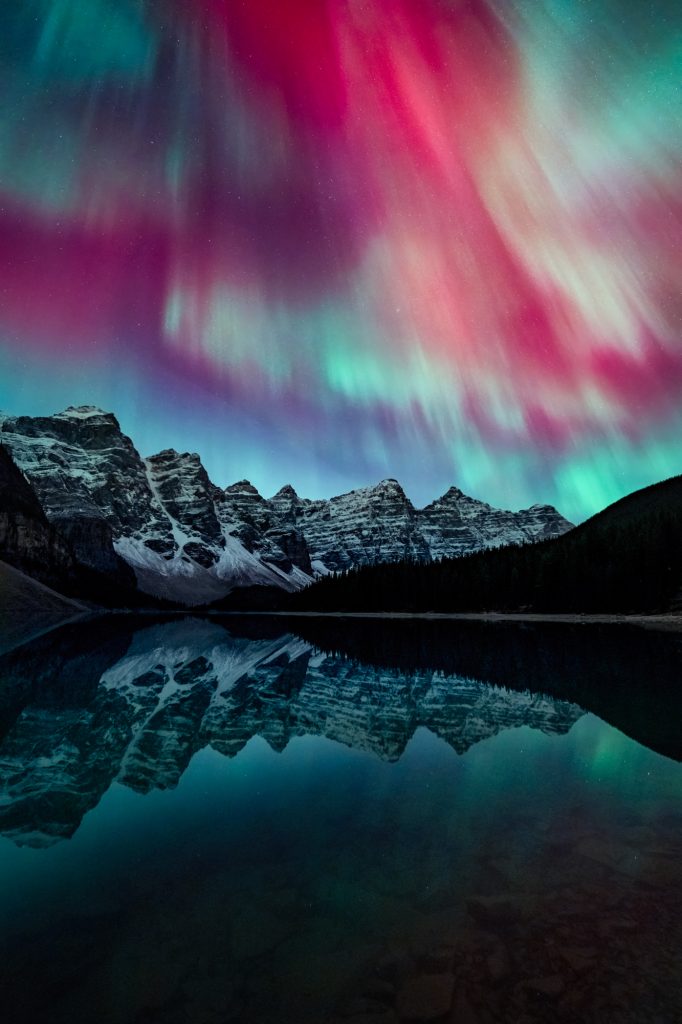
Our long winter nights, and the approach of solar maximum also make November a great opportunity to see the enchanting dance of the Aurora Borealis. Last November we had Kp6 and Kp8 conditions! At this latitude (51 degrees North), a Kp4 aurora can be seen when looking north, and a Kp5 is seen as dancing pillars of light. At Kp6, the aurora can be seen overhead and in any direction. At Kp8, you can film the dancing lights with your cell phone; it’s an utterly breathtaking experience!
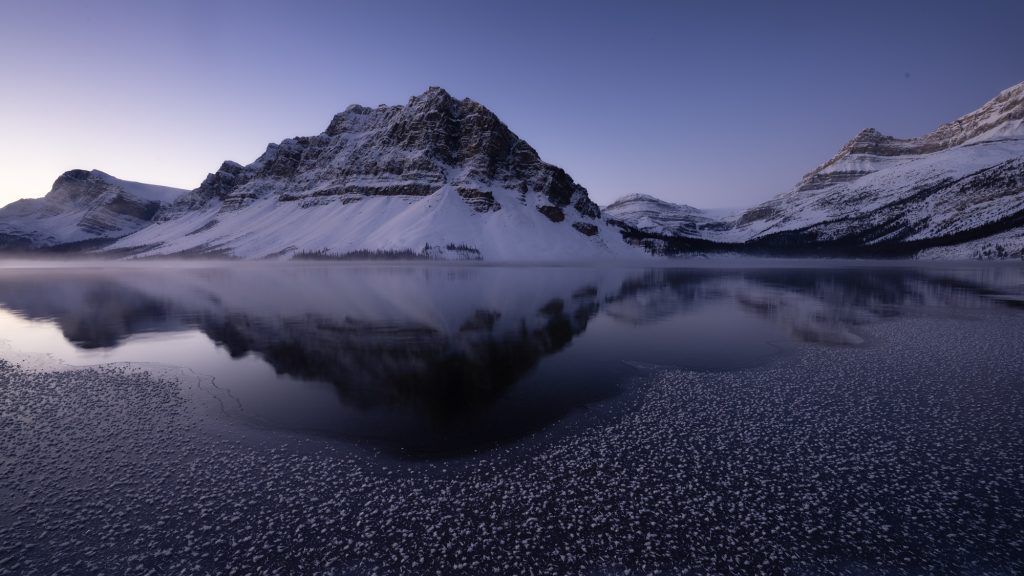
It wouldn’t be a winter night in the Rockies without getting a glimpse of Orion floating through the night sky. For this workshop, I will have star trackers available to help you capture the nebulosity around Orion, and the amazing colour of the stars. If you have never tried an astro-tracker, this is a good opportunity to try long exposures at lower ISOs. This method helps to preserve colour in the stars, and enables shooting at narrower apertures, and thus capturing sharper stars.
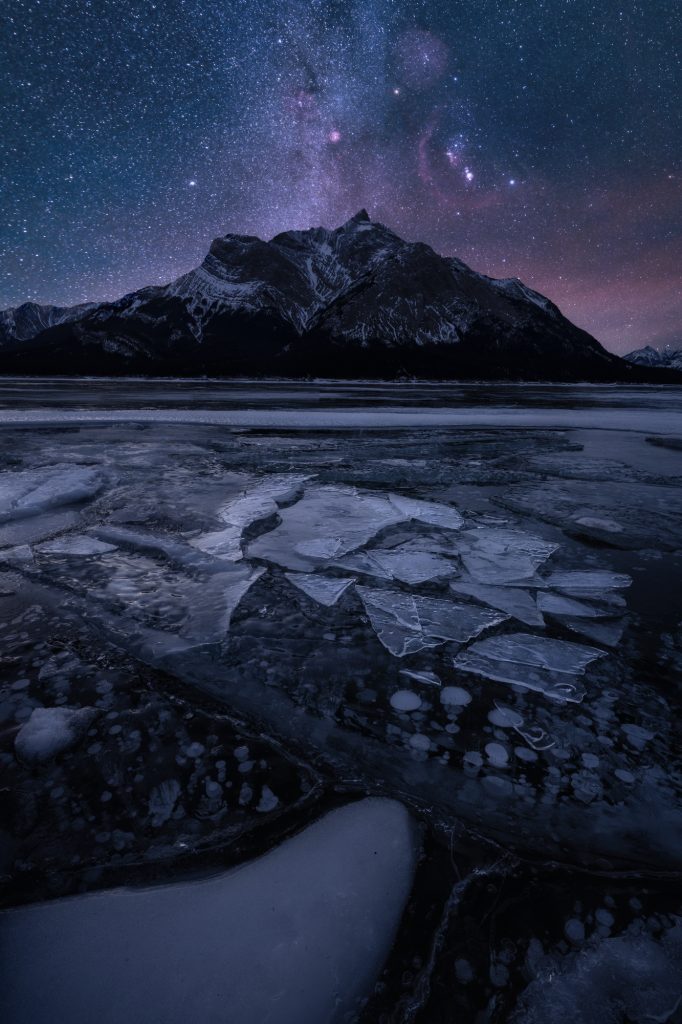
If you have an astro-modified camera, bring it! Although astro-modified cameras are not necessary for the workshop, they are amazingly fun to use and bring out the fullness of the nebulosity around Orion.
Canadian Rockies Photography Workshop – Winter Skies
The Plan… The following is a typical plan for our time in the Canadian Rockies during our November expedition. Of course, Mother Nature doesn’t always cooperate so it’s important to be flexible and have alternate plans. For example, if it is snowing in Banff I can just shuffle the plan for the day in Banff with a day out at Abraham Lake, or skip a sunrise to shoot aurora. The goal is to maximize our chances of good light, atmospheric conditions, and aurora. And when the light is less favourable for photography we will use the time in class to cover topics like how to shoot aurora, and how to blend blue hour foregrounds with starry skies.
Day 1: Welcome to the Canadian Rockies!
It’s Sunday morning…
And you land in an early flight at the YYC Calgary International Airport in Calgary, Alberta, Canada.
Although I suggest arriving the day before and staying at a hotel near the airport to have time to rest a bit before the action begins and to avoid any winter travel delays. I recommend the Hotel 11, MOD A Sonesta Collection.
10:00 am
After picking you up at the airport (or at the Hotel 11), we’ll continue our journey towards the Rockies.
Due to its wonderful pristine nature, the Canadian Rockies have been included in the UNESCO World Heritage-list. The magnificent mountains stretch for about 180,000 km2 (69,500 mi2) through Alberta and British Columbia.
12:30 am
We arrive at the village of Canmore, located in the Bow Valley within Alberta’s Rocky Mountains, where the comfortable Hidden Ridge Resort will be our base and home for the rest of the week.
Check-in starts at 4pm so we’ll spend some time buying groceries, snacks, clothes or anything else that you may need during the expedition.
12:00 pm: Lunch at a local restaurant. What about having the crispy skin salmon, the bison sirloin or the Buddha bowl? Delicious!
1:30 pm Expedition Briefing & How to shoot Aurora!
4:00 pm departure for sunset. The days are getting shorter, and nights are getting longer. Today we’ll photograph Sunset and, if lucky, the Aurora in Lake Minnewanka, located in Banff.
Lake Minnewanka is a super large glacial lake. It’s 21 km (13 mi) long and 142 m (466 ft) deep.
The lake is surrounded by a stunning mountain range. Among the peaks, we find Mount Inglismaldie (2,964m or 9,724 ft) and Mount Girouard (2,995m or 9,826 ft).
7:30 pm: What happens after Sunset will depend on the Aurora forecast and the cloud layer. If there are chances of getting the Aurora dancing in the sky, we’ll stay and enjoy the show. Get your snacks and groceries ready!
On the contrary…
If there is no Aurora, we’ll pack up and go back to the hotel where we’ll enjoy a well deserved dinner and prepare for an early morning departure.
Day 2: The Turquoise Fox! (Or is it a wolf…?)
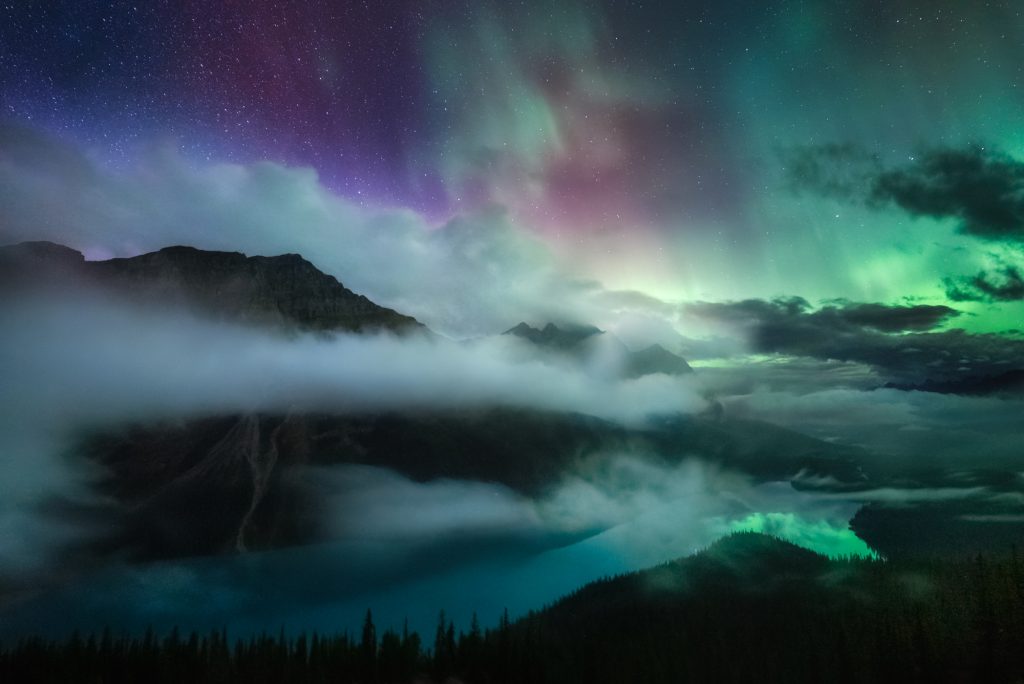
2:00 am: Wake up! We’re going to photograph the Aurora (and the stars) at the beautiful Peyto Lake.
4:00 am: Do you see the wolf? Owing its existence to Peyto Glacier, Peyto Lake is a natural masterpiece—a jewel nestled in the heart of the Canadian Rockies.
Its vibrant turquoise waters, surrounded by majestic mountains and pristine wilderness, create a sensory experience that is nothing short of extraordinary.
Now, add to the mix that the lake has the shape of the head of a wolf (see photo below) and that we’ll be framing north… And we couldn’t ask for a better place to photograph the Aurora (and the stars).
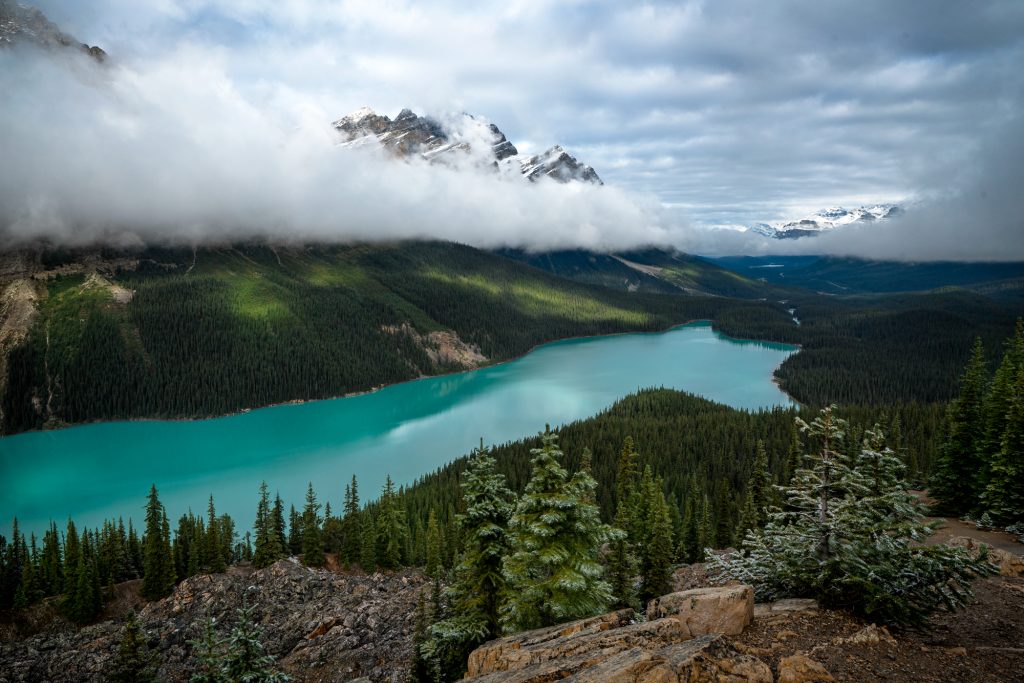
7:30 am: As the blue hour begins, the scene changes completely. The sky is filled up with beautiful cold colors. Later, as the Sun rises, the blues give way to the reds and oranges. The colors of the golden hour…
Colors that fall on Mt. Patterson (3,552 m or 11,654 ft), Candron Peak (2,911 m or 9,550 ft) and Peyto Lake, just in front of us.
9:30 am: Breakfast in a local café.
11:30 am: Nap time (siesta) at the lodge.
1:00 pm: Because we understand that you prefer to have more sleeping time, lunch will be on your own. When you’re hungry, get up and go grab lunch at the lodge restaurant. Our suggestion: rest and sleep as much as you can to be fresh and ready in the field.
After a relaxing sleep and a 30 min drive, we arrive at Vermilion Lakes, our Sunset and Orion destination in Bow Valley. Here the view of Mount Rundle (2,948m or 9,672ft) and Sulphur Mountain (2,451m or 8,041ft) is spectacular.
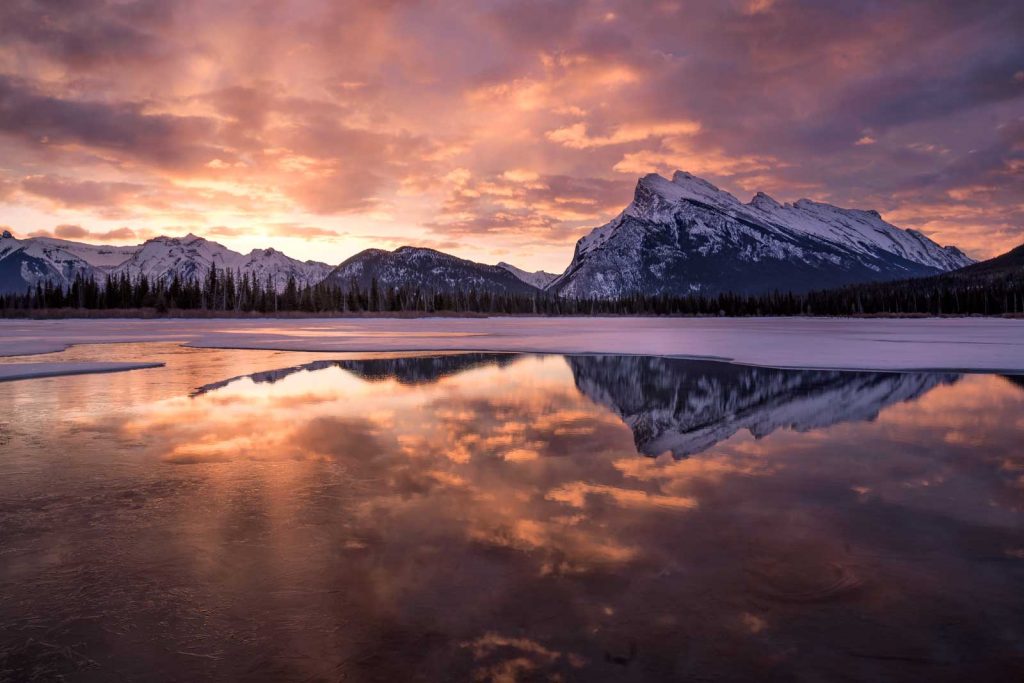
We’re shooting towards the south. The Sun is setting in the west casting the afternoon golden light on Mount Rundle’s characteristic shape. In my opinion, the rock formation resembles the back of a dragon… What do you think?
We’ll shoot here until the end of blue hour.
6:00 pm: Dinner at a local restaurant.
8:00 pm: It’s nighttime. If the skies are clear, we’ll photograph the constellation of Orion over the majestic Mt. Rundle.
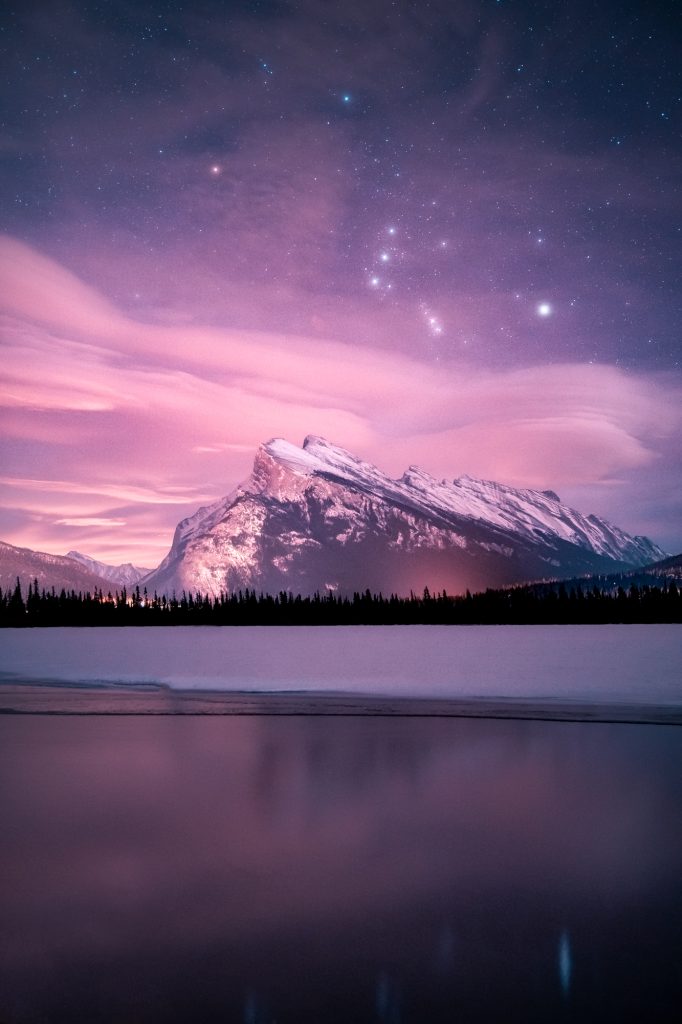
12:00 am: Bed time.
Day 3: Frost Flowers and the Red Train
7:30 am: We arrive at our Sunrise spot. Morant’s curve is located in Lake Louise, about 1h drive away from our lodge. What’s so unique about this curve?
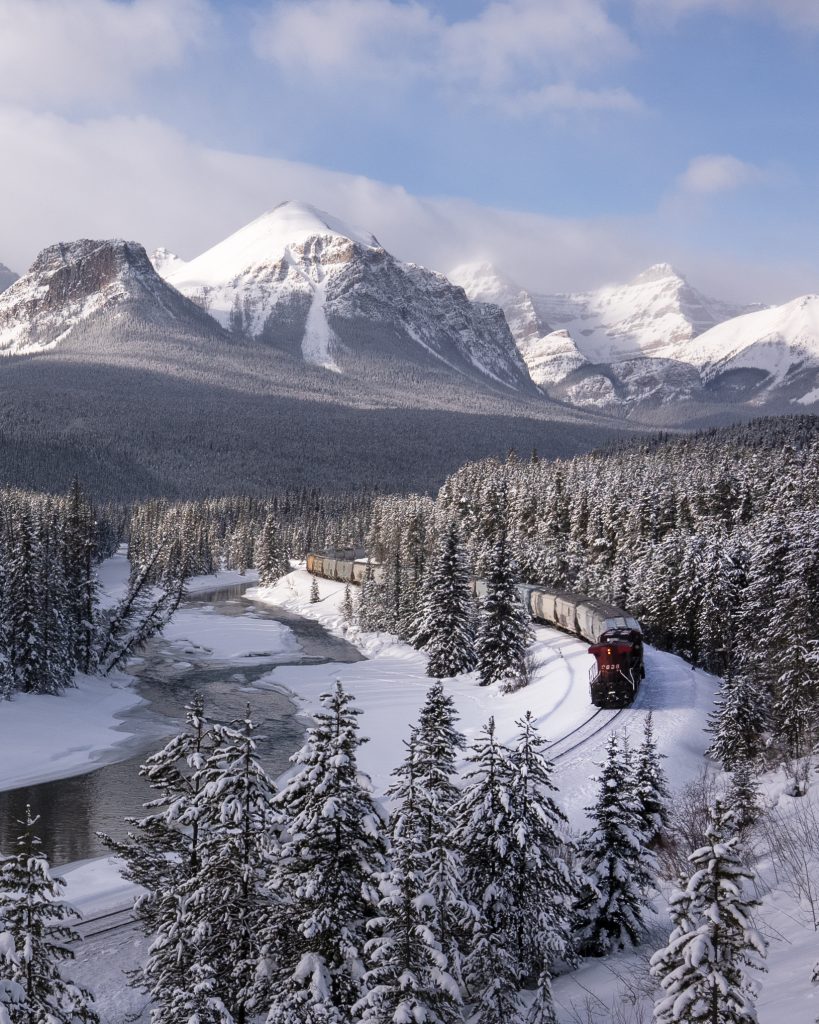
Well… The story involves a train… Morant’s Curve gets its name from Nicholas Morant, a photographer working for the Canadian Pacific Railway in the mid 20th century. His photos helped promote the railway and the Canadian Rockies. So, in addition to the stunning mountains and the Bow River, the Canadian Pacific Railway train wraps itself through the beautiful scenery.
And this is what we want, to photograph the Red Engine train slowly traveling along the valley, next to the Bow River and among the mountains: Mount Temple (3,544m or 11,627ft), Mount Aberdeen (3,152m or 10,341ft), Popes Peak (3,163m or 10,377ft), and Waputik Peak (2,755m or 9,039ft)…
9:00 am: Breakfast at the Trailhead Café in Lake Louise.
1:00 pm: Lunch at a local restaurant and siesta!
3:45 pm: Bow Lake is located on the Icefields Parkway, about 1 h and 30 min away from our lodge.
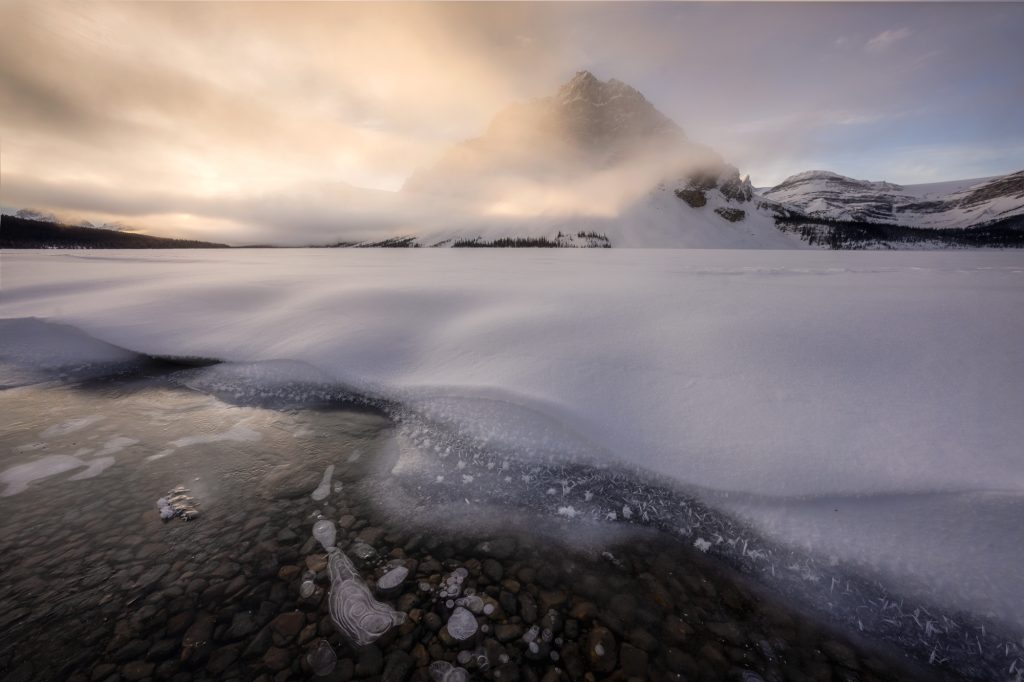
The impressive rock wall of Crowfoot Mountain (3,055m or 10,023ft), the glacier, and the infinite Wapta Icefield provide us with a unique photo opportunity. And, on top of that, let’s add some frost flowers in the foreground and the afternoon golden light falling on Crowfoot Mountain. Cherry on the cake!
6:00 pm: Dinner at a local restaurant.
8:00 pm: We want clear skies, we pray for clear skies… because our goal is to photograph a panorama of Orion while rising over Bow Lake. We would also accept aurora…
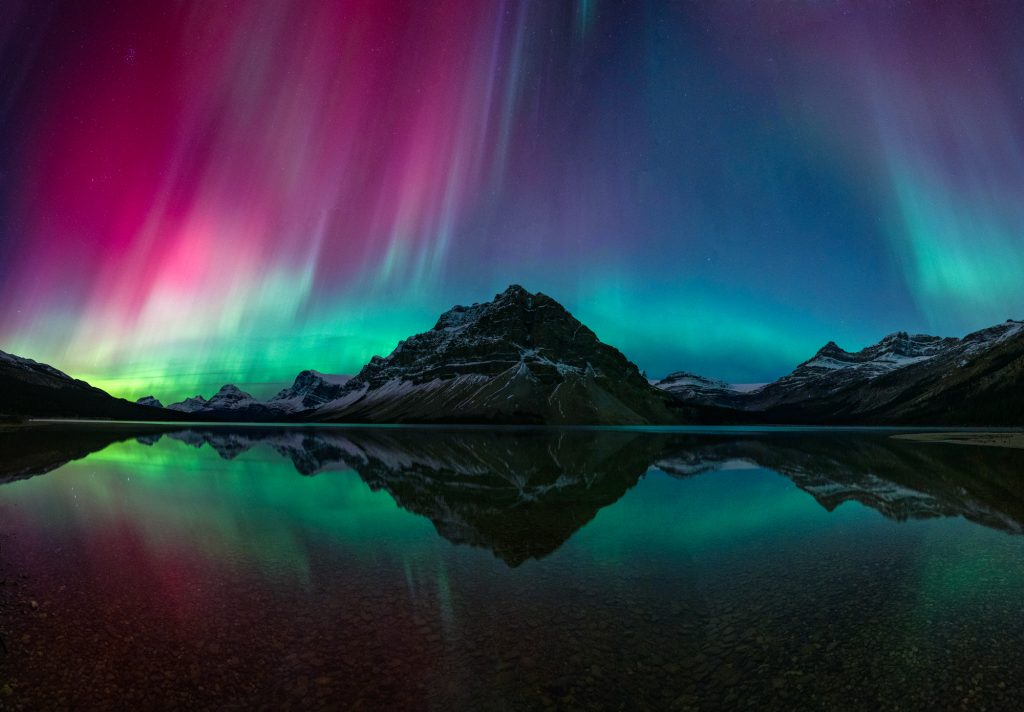
12:30 am: It’s been a long long day… From Sunrise to Sunset, and then at night, we’ve been chasing a red train, the golden light, the Sun and Orion’s belt…
Tomorrow another adventure awaits!
Day 4: It’s a surprise!
I’ve been giving you lots of details of this amazing expedition to the Canadian Rockies. Maybe far too many… But on November 6th we’ll do something very special… What will that be? Well, you’ll have to be there, with us, to find out! 😛
Day 5: The Lake and the Peak
4:00 am: Wake up! Today we’ll photograph Sunrise at Abraham Lake and Sunset at Tangle Peak.
6:30 am: It takes a 2h drive to get to Abraham Lake. This man-made lake boasts a serene and ethereal charm that sets it apart from other bodies of water. Stretching across vast expanses, Abraham Lake showcases a mesmerizing blend of azure blue waters and icy landscapes, creating a sight that is both enchanting and awe-inspiring. As the Sun goes up, the golden morning light will fall on Mt. Michener (2,545m or 8,350ft). And there we’ll be, ready to press the shutter.
9:00 am: Time for breakfast.
11:00 am We’ll have lunch in Nordegg and enjoy the beautiful scenery of the Columbia Icefields.
3:30 pm: Tangle Ridge is an impressive 3,000m (9,800ft) mountain summit located in Jasper National Park. Due to its pointy shape, it forms a beautiful triangle under the stars. We’ll arrive with enough time to find our Sunset shooting spot… and also our Orion composition.
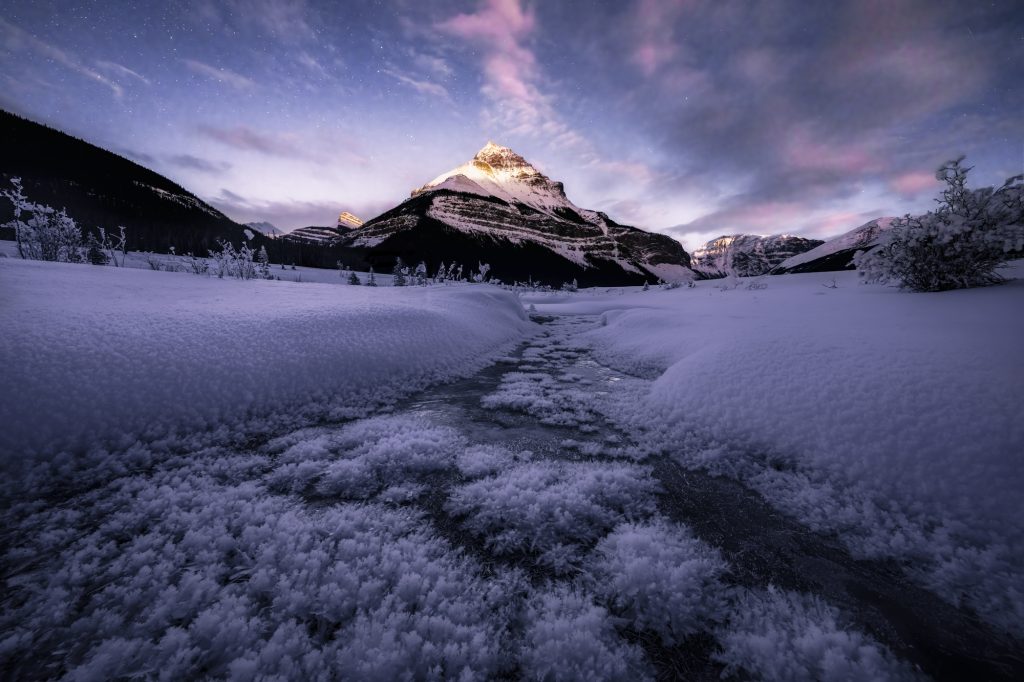
6:00 pm: Dinner in the field!
8:00 pm: The Moon is below the horizon. The sky is pitch black. There is zero light pollution here. We’re enjoying a Bortle Class 1 sky. Very soon, the Orion belt will be rising on the left side of the point mountain in front of us.
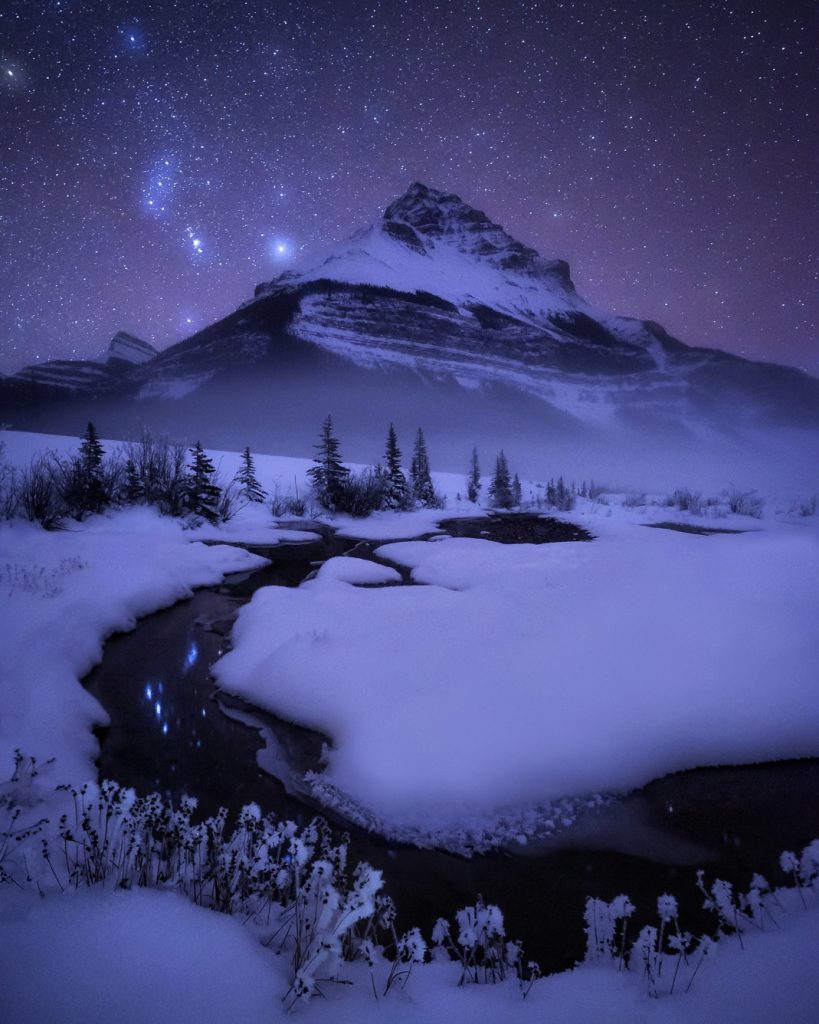
And if the Aurora shows up… we’ll shoot all night here!
1:30 am: Bed time!
Day 6: Chasing Frozen Bubbles
9:30 am: After a good sleep, we’ll have a slow breakfast at our lodge.
11:00 am: Editing class with Rachel. I’ll walk you through the entire workflow in creating my dreamy night-caps, including image editing, blending, focus stacking and more!
1:00 pm: We’ll take the lunch bags and we’ll jump into the vehicles to go to our next Sunset and Aurora Borealis destination: Abraham Lake.
4:00 pm: In early November, if it’s cold enough for the lake to freeze (not guaranteed!), a curious phenomenon occurs here in Abraham Lake: methane bubbles get trapped between the layers of ice.
The methane bubbles are produced by the bacteria eating dead organic matter at the bottom of the lake. As they float upwards towards the surface, the bubbles get trapped in the ice… Creating a unique foreground for our photos!
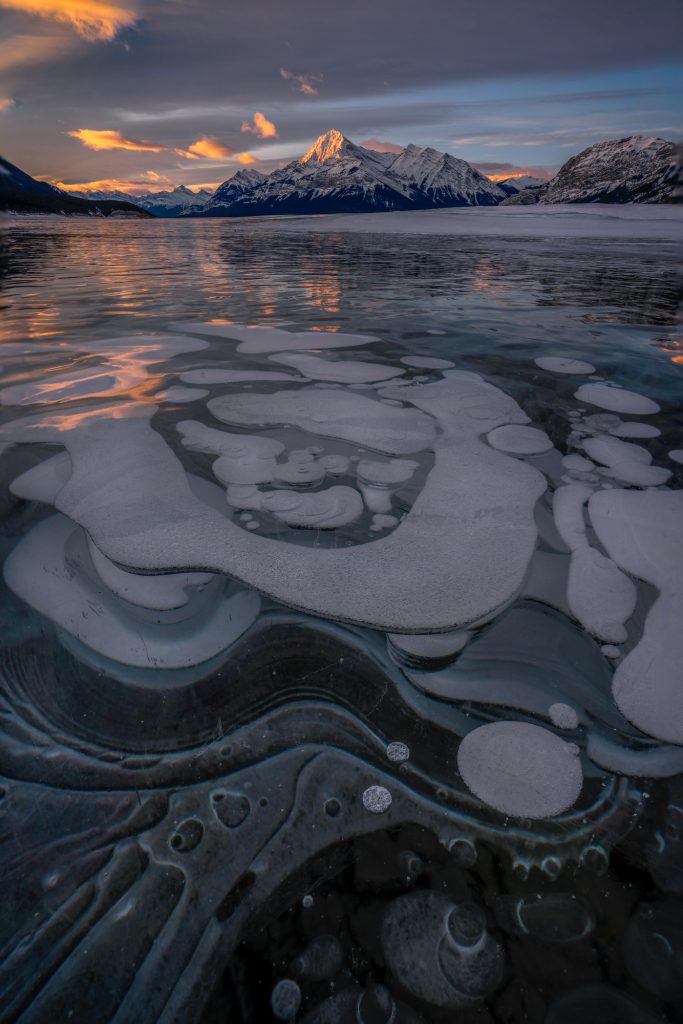
If there are no bubbles, then, we’ll use patterns in the lake to compose our shots with the peaks!
Dinner in the field. If we are very lucky, we may get to photography the aurora while we are here.
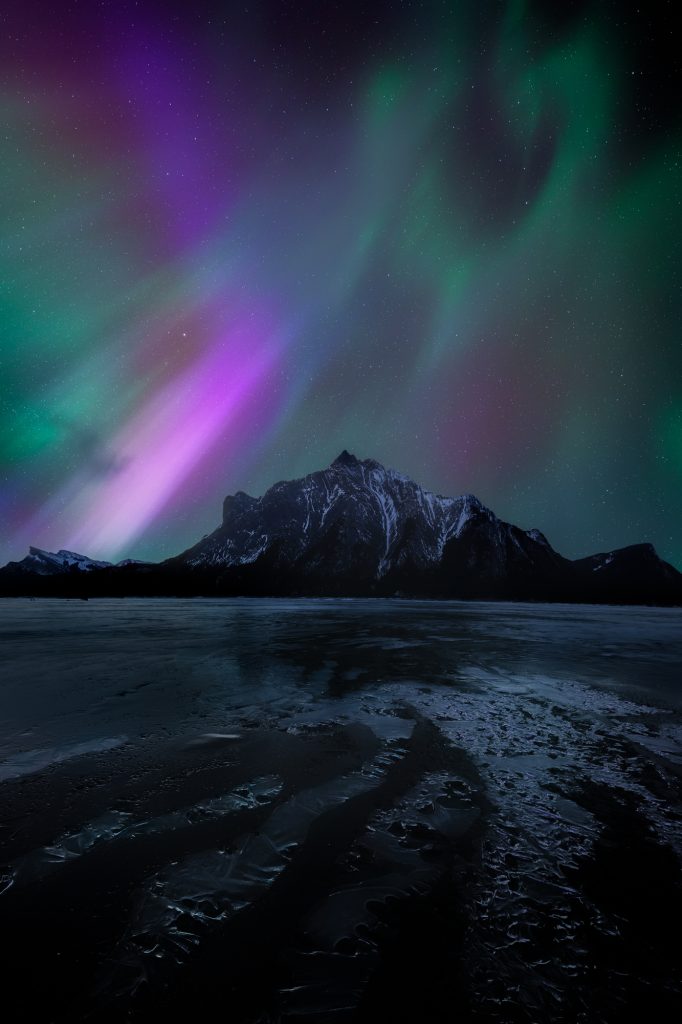
If the Aurora finally doesn’t occur, we’ll stay and photograph Orion.
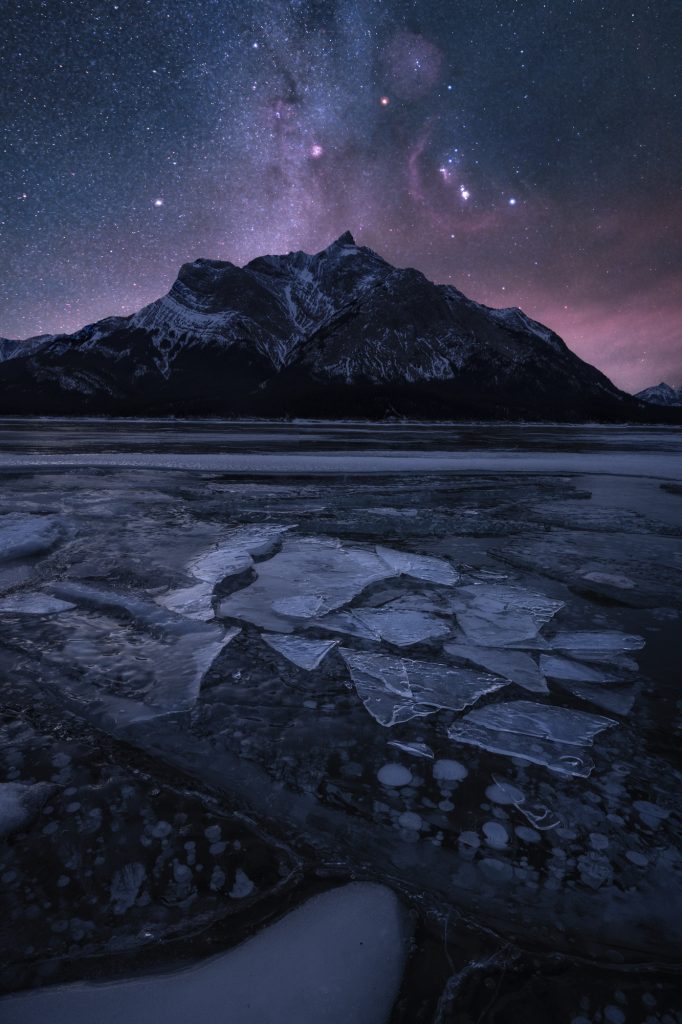
10:00 pm: One thing we love about Abraham Lake is the multiple photography options that it offers. We could spend several days just photographing the frozen lake, the trees, the mountains… and Orion!
If the skies are clear, we’ll spend hours photographing Orion, and if we’re lucky, the Aurora, until well past midnight.
12:00 am: We’re driving back to our Lodge. It’s a 2h 30min long drive, but we’re so happy after an incredible night of shooting. Whether we get the Aurora, Orion or the clouds, the photos we bring home deserve being hung on the wall!
2:30 am: Bed time! Tomorrow we’re going home.
Day 7 – One Last Sunrise & Farewells
Today we will visit the majestic Mount Rundle at Vermilion Lakes in Banff. As the Sun is rising in the east, it creates the perfect conditions for crepuscular rays if we have the right cloud conditions.
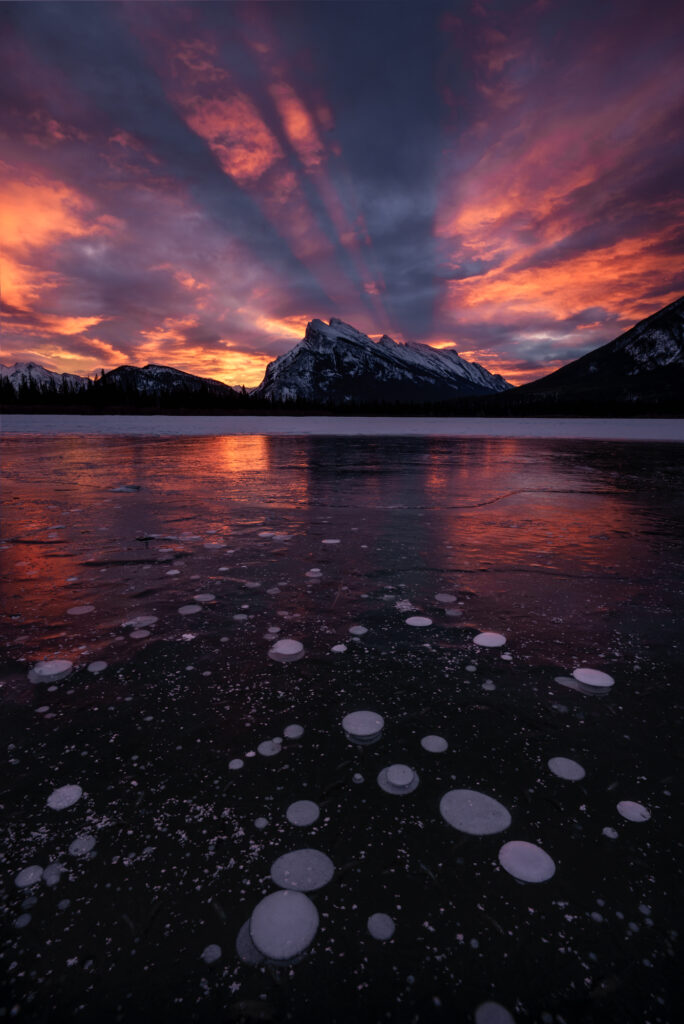
11:00 am: After a copious breakfast at Juniper Bistro, we will make our way back to Calgary Airport, where we expect to arrive at about 4:00 pm.
It’s time to say goodbye.
See you soon friends!
What’s Included on the Expedition:
- A 7-day expedition photographing the Canadian Rockies
- 7 days of learning, fun and adventure with Rachel Jones Ross
- 6 nights of lodging
- All activities on the surprise day
- Ground transportation during the expedition
- All transfers
- Park Passes
What’s not included:
- Flights/transport to Calgary, Canada
- Medical and travel insurance coverage (required)
- Breakfast, lunch & dinner
- Snacks, alcohol and beverages
- Visa
- Anything not mentioned in the “included” list
Weather
The weather in November is variable with average high temperatures around 0 degrees Celsius and average low temperatures around -10 degrees Celsius. However, it is not uncommon to get a ‘cold snap’ with temperatures as low as -20 degrees Celsius. The cold is a ‘dry’ cold and is easily managed with good layers. Check out my “Recommended Gear” post for everything you need to know for a winter workshop with me, including travel recommendations.
More Details
We have six nights and seven days to fill your memory cards!
Available Dates:
November 9-15, 2025 with co-guides Kah-Wai Lin & Matt Seuss
December 2-8, 2025 with co-guides Kai-Wai Line & Mark Denney
Maximum group size is 10 participants.
*Deposits are non-refundable.

About Me
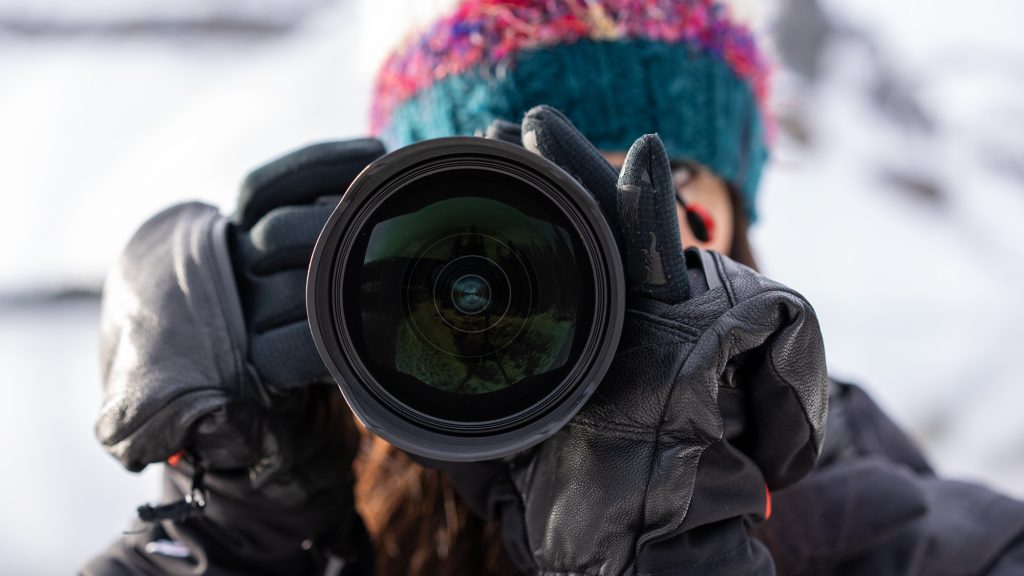
There is little that inspires me more than a sky full of stars! A few years ago I embarked on a personal project to spend 100 nights under the stars. That project really opened my eyes to the incredible beauty of the night sky, in ways that I had never anticipated. I had always thought about night shooting as getting out on the darkest nights to shoot the Milky Way or aurora. However, I soon learned that moonrise and moonset can be completely captivating, that moonlight is an ally to capturing the aurora, and that winter nights are most captivating, even in the absence of the Milky Way core.
I am a passionate educator. It is my goal to ensure you leave this workshop with the skills and confidence to shoot in any low light situation.
The workshop starts in Calgary, Canada. It is $4499 for a double occupancy room, or $4999 for a single occupancy room. A deposit of $1000 is due at sign-up to hold your spot. You can use the ‘balance remaining’ buttons to pay the balance (due 120 days prior to the workshop start date). All prices are in USD.
Please do not hesitate to contact me if you have any questions!
